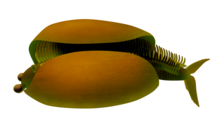Odaraia
| Odaraia Temporal range: | |
|---|---|

| |
| Fossil | |

| |
| Life restoration in presumed upside down swimming position | |
| Scientific classification | |
| Domain: | Eukaryota |
| Kingdom: | Animalia |
| Phylum: | Arthropoda |
| Order: | †Hymenocarina |
| Family: | †Odaraiidae Simonetta & Delle Cave, 1975 |
| Genus: | †Odaraia Walcott, 1912 |
| Species: | †O. alata |
| Binomial name | |
| †Odaraia alata Walcott, 1912 | |
| Synonyms | |
| |

Odaraia is a genus of bivalved arthropod from the Middle Cambrian. Its fossils, which reach 15 centimetres (5.9 in) in length,[1] have been found in the Burgess Shale in British Columbia, Canada.
Odaraia bore a large pair of eyes at the front of its body,[1] and may have had two smaller eyes in between.[2] It had a tubular body with at least 45 pairs of biramous limbs, and its tail had three fins – two horizontal, one vertical – which were used to stabilise the animal as it swam on its back.[1] It has been suggested to have been an actively swimming filter feeder or predator, using its limbs to capture or sift food items from the water column, before using its appendages to transfer food to its mouth.[1][3]
Material from the Burgess Shale described in 2024 preserved specimens with hitherto-undetected mandibles, a mechanism for predation, as well as spinose endites on certain limbs, a possible mechanism for filter-feeding.[4]
217 specimens of Odaraia alata are known from the Greater Phyllopod Bed, where they comprise 0.41% of the community.[5]
It is currently classified as a member of Hymenocarina, a group containing many bivalved arthropods.[6]
See also
Further reading
- Simon Conway Morris (1997). The Crucible of Creation: the Burgess Shale and the Rise of Animals. Oxford University Press. ISBN 978-0-19-286202-0.
- Hou Xian-Guang; Richard J. Aldridge; Jan Bergström; David J. Siveter & Feng Xiang-Hong (2004). The Cambrian Fossils of Chengjiang, China: the Flowering of Early Animal Life. John Wiley & Sons. ISBN 978-1-4051-0673-3.
References
- ^ a b c d D. E. G. Briggs (1981). "The arthropod Odaraia alata Walcott, Middle Cambrian, Burgess Shale, British Columbia". Philosophical Transactions of the Royal Society B: Biological Sciences. 291 (1056): 541–582. Bibcode:1981RSPTB.291..541B. doi:10.1098/rstb.1981.0007. JSTOR 2395403.
- ^ Graham E. Budd (2008). "Head structure in upper stem-group euarthropods". Palaeontology. 51 (3): 561–573. Bibcode:2008Palgy..51..561B. doi:10.1111/j.1475-4983.2008.00752.x. S2CID 85297530.
- ^ "Odaraia alata". The Burgess Shale. Royal Ontario Museum.
- ^ Izquierdo‐López, Alejandro; Caron, Jean‐Bernard (24 July 2024). Barrett, Spencer (ed.). "The Cambrian Odaraia alata and the colonization of nektonic suspension-feeding niches by early mandibulates". Proceedings of the Royal Society B. 291 (2027): 20240622. doi:10.1098/rspb.2024.0622. ISSN 1471-2954.
- ^ Jean-Bernard Caron & Donald A. Jackson (2006). "Taphonomy of the Greater Phyllopod Bed community, Burgess Shale". PALAIOS. 21 (5): 451–465. Bibcode:2006Palai..21..451C. doi:10.2110/palo.2003.P05-070R. S2CID 53646959.
- ^ Izquierdo‐López, Alejandro; Caron, Jean‐Bernard (November 2021). Zhang, Xi‐Guang (ed.). "A Burgess Shale mandibulate arthropod with a pygidium: a case of convergent evolution". Papers in Palaeontology. 7 (4): 1877–1894. doi:10.1002/spp2.1366. ISSN 2056-2799. S2CID 236284813.
External links
- "Odaraia alata". Burgess Shale Fossil Gallery. Virtual Museum of Canada. 2011. Archived from the original on 2020-11-12.
- Odaraia in the Paleobiology Database

